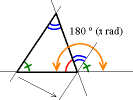|
Sum of angles of a triangleIn a Euclidean space, the sum of angles of a triangle equals a straight angle (180 degrees, π radians, two right angles, or a half-turn). A triangle has three angles, one at each vertex, bounded by a pair of adjacent sides. The sum can be computed directly using the definition of angle based on the dot product and trigonometric identities, or more quickly by reducing to the two-dimensional case and using Euler's identity. It was unknown for a long time whether other geometries exist, for which this sum is different. The influence of this problem on mathematics was particularly strong during the 19th century. Ultimately, the answer was proven to be positive: in other spaces (geometries) this sum can be greater or lesser, but it then must depend on the triangle. Its difference from 180° is a case of angular defect and serves as an important distinction for geometric systems.  CasesEuclidean geometryIn Euclidean geometry, the triangle postulate states that the sum of the angles of a triangle is two right angles. This postulate is equivalent to the parallel postulate.[1] In the presence of the other axioms of Euclidean geometry, the following statements are equivalent:[2]
An easy formula for these properties is that in any three points in any shape, there is a triangle formed. Triangle ABC (example) has 3 points, and therefore, three angles; angle A, angle B, and angle C. Angle A, B, and C will always, when put together, will form 360 degrees. So, ∠A + ∠B + ∠C = 360° Spherical geometrySpherical geometry does not satisfy several of Euclid's axioms, including the parallel postulate. In addition, the sum of angles is not 180° anymore. For a spherical triangle, the sum of the angles is greater than 180° and can be up to 540°. The amount by which the sum of the angles exceeds 180° is called the spherical excess, denoted as or .[4] The spherical excess and the area of the triangle determine each other via the relation (called Girard's theorem):where is the radius of the sphere, equal to where is the constant curvature. The spherical excess can also be calculated from the three side lengths, the lengths of two sides and their angle, or the length of one side and the two adjacent angles (see spherical trigonometry). In the limit where the three side lengths tend to , the spherical excess also tends to : the spherical geometry locally resembles the euclidean one. More generally, the euclidean law is recovered as a limit when the area tends to (which does not imply that the side lengths do so).  A spherical triangle is determined up to isometry by , one side length and one adjacent angle. More precisely, according to Lexell's theorem, given a spherical segment as a fixed side and a number , the set of points such that the triangle has spherical excess is a circle through the antipodes of and . Hence, the level sets of form a foliation of the sphere with two singularities , and the gradient vector of is orthogonal to this foliation. Hyperbolic geometryHyperbolic geometry breaks Playfair's axiom, Proclus' axiom (the parallelism, defined as non-intersection, is intransitive in an hyperbolic plane), the equidistance postulate (the points on one side of, and equidistant from, a given line do not form a line), and Pythagoras' theorem. A circle[5] cannot have arbitrarily small curvature,[6] so the three points property also fails. The sum of angles is not 180° anymore, either. Contrarily to the spherical case, the sum of the angles of a hyperbolic triangle is less than 180°, and can be arbitrarily close to 0°. Thus one has an angular defectAs in the spherical case, the angular defect and the area determine each other: one haswhere and is the constant curvature. This relation was first proven by Johann Heinrich Lambert.[7] One sees that all triangles have area bounded by . As in the spherical case, can be calculated using the three side lengths, the lengths of two sides and their angle, or the length of one side and the two adjacent angles (see hyperbolic trigonometry). Once again, the euclidean law is recovered as a limit when the side lengths (or, more generally, the area) tend to . Letting the lengths all tend to infinity, however, causes to tend to 180°, i.e. the three angles tend to 0°. One can regard this limit as the case of ideal triangles, joining three points at infinity by three bi-infinite geodesics. Their area is the limit value . Lexell's theorem also has a hyperbolic counterpart: instead of circles, the level sets become pairs of curves called hypercycles, and the foliation is non-singular.[8] Exterior angles Angles between adjacent sides of a triangle are referred to as interior angles in Euclidean and other geometries. Exterior angles can be also defined, and the Euclidean triangle postulate can be formulated as the exterior angle theorem. One can also consider the sum of all three exterior angles, that equals to 360°[9] in the Euclidean case (as for any convex polygon), is less than 360° in the spherical case, and is greater than 360° in the hyperbolic case. In differential geometryIn the differential geometry of surfaces, the question of a triangle's angular defect is understood as a special case of the Gauss-Bonnet theorem where the curvature of a closed curve is not a function, but a measure with the support in exactly three points – vertices of a triangle.
See also
References
|
Portal di Ensiklopedia Dunia








![{\textstyle [A,B]}](https://wikimedia.org/api/rest_v1/media/math/render/svg/a349071785ec000dee0ac06710790df403a55bac)













